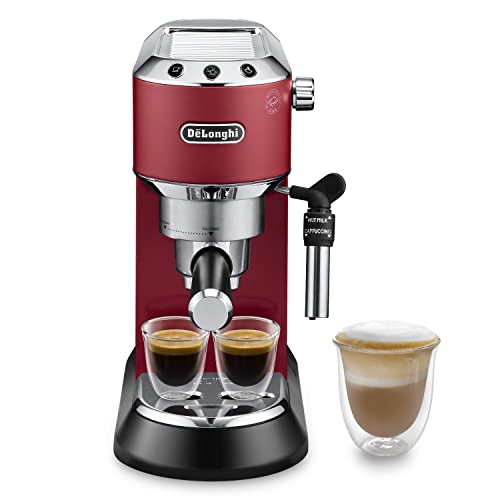Nine Things That Your Parent Taught You About Machine Espresso
 How Does Machine Espresso Work?
How Does Machine Espresso Work?Machine espresso utilizes precise pressure and amazing filter technology to make the delicious coffee we enjoy. How does it work exactly?
To make espresso hot water is forced under high pressure through finely ground coffee. The process is similar to making drip coffee. However, the pressure is the primary difference.
The Group Head
As the name suggests, the group head is where you place your portafilter while brewing espresso. It is responsible for dispersing the water into the portafilter, and controlling the pressure of the extraction. There are a variety of types of group heads, each with their unique advantages and disadvantages. Some are specifically designed for the stability of temperature while some are designed to handle pre-infusion. Others are built to control the lever. There are even some that have a combination of features, such as the E61 that is the most popular choice among baristas due to its capacity to provide multiple benefits in a single package.
As you can see in the above photo, the group head has numerous notches that you can place your portafilter and twist it with your hands to lock it in. A gasket of rubber is situated inside the notches, which helps create a seal when you insert your portafilter. The notches on the head allow for a precise position of the portafilter which is essential to ensure an even extraction.
In addition to allowing you effortlessly insert your portafilter the group head is responsible for Machine Espresso maintaining an even temperature. It does this by cycling hot water through the brew basket, and around the portafilter, ensuring that it's always at the correct temperature for extraction. This is crucial, since just a few degrees could make the difference between a good and great espresso.
The Pump
The motorized pumps in rotary espresso machines provide the nine atmospheric bars of pressure required to extract espresso. This is different from manual piston machines that rely on levers. This pressure builds up by drawing tap water from a reservoir and pumping it through a heat exchanger prior it is shot through the ground coffee in the group head.
Pumps tend to be cheaper than piston-driven machines, and tend to last longer. However, both types of machine can become damaged due to excessive use and poor cleaning. Pumps are also more complex mechanically, Machine espresso which can increase prices of even simplest models.
Certain espresso machines utilize steam pressure instead of a pump to make espresso. This can result in over-extraction because the boiler that makes steam also heats the water until it comes to a boil. They also have to constantly rebuild their pressure between cups. This requires energy and time.
Many espresso machines employ the rotary or vibration pump, which has a vibration model that uses a vibrating disc that generates the pressure and rotating models that push hot water through the grounds at high speed. Both machines can make excellent espresso, however rotary machines are more quiet, durable and less likely to fail.
The Boiler
The boiler is what makes the water warm to the perfect temperature to extract. The steam created gets to the portafilter which contains the espresso coffee espresso machine grounds. It is then pumped into the cup. During this process the steam creates enough pressure to push the grounds of coffee machine espresso through. This creates a foam on top of the espresso. This is one of the hallmarks of a great italian espresso machine.
There are three types of pro espresso machine makers, and they differ in the kind of pump they use and how hot the coffee is. There are various ways to control the brew as well as the size of cup that can be produced by the machine.
The first espresso machines were steam-types. The earliest espresso machines were steam types. The coffee tasted bitter and burnt. The modern espresso machine was created by the Milanese makers Luigi Bezzerra & Desiderio Pavoni.
The most commonly used espresso machine is a semiautomatic one with an electric pump. These are what people imagine when they think of an espresso machine. Semi-automatic machines require you to grind and tamp the beans on your own while the pump controls the water flow and pressure. This is an excellent solution that combines human control with mechanized reliability.
The Filter
Typically, espresso machines employ a filter to separate out the grounds of coffee as they move through the hot water. The filter is also an essential element of the temperature control system, because it stops the machine from overheating.
Filters also aid in flavor because it allows for the beans to flower for a longer period of time. This lets the beans release their flavor and also allows for better extraction.
However, it is important to remember that even a top filter can result in a poor cup of coffee, since the quality of the beans and extraction is crucial.
This is where the magic happens, it's the thing that makes espresso taste great. The grouphead (also known as the brewhead) is where you place the portafilter, the device that you put the coffee espresso machines grounds into, while making espresso.
In a steam-driven espresso machine hot water is heated in an airtight tank to produce steam, which is then pushed through the grounds under high pressure. They are less expensive and easier for the user to maintain than pumps-driven models. They are however limited in their ability to create the perfect brewing conditions as they only operate with 1-1.5 bar of pressure. The ideal shot requires 9-10 bars.
In recent years, espresso machines powered by a compressed air pump have become increasingly popular. They utilize an air compressor to push hot water across the ground and are more mobile than steam-driven electric espresso machines.



